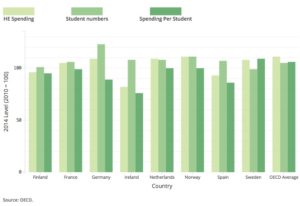 In this brave new data world, we seem to get daily reports on the latest statistics about education. It si not easy making sense of it all.
In this brave new data world, we seem to get daily reports on the latest statistics about education. It si not easy making sense of it all.
Times Higher Education reports on OECD’s latest Education at a Glance report, an annual snapshot of the state of education across the developed world, published on 12 September.
It shows spending per higher education student significantly falling behind the OECD average in a number of European countries such as Spain, Italy, Slovenia and Portugal, while even countries with reputations for strong university systems, such as Germany and Finland, are failing to keep pace with the US and UK.
But what does all this mean? Germany has significantly increased University places as a response to the crisis, seemingly without spending per student keeping pace. The UK has increased spedning er student. The different of course is that while higher education is basically free in Germany, the UK has some of the highest university tuition fees in the world. Andreas Schleicher from OECD said that since there were no comparable data on learning outcomes for different countries, it was difficult to pinpoint whether the large per-student spends in some nations were actually improving quality.
However, according to the THE report, he added that results from the OECD’s international school testing programme – the Programme for International Student Assessment (Pisa) – showed “that there is essentially no relationship between spending per student and school performance once you get beyond a certain threshold in spending”, a point that most OECD countries had already passed.
Of course school performance does not necessarity equate with quality of teaching and learning. But it does suggest that even with the deluge of data we still do not understand how to judge quality - still ess hwo to improve it.








